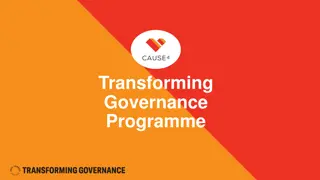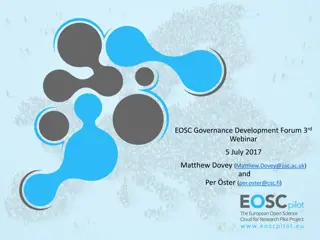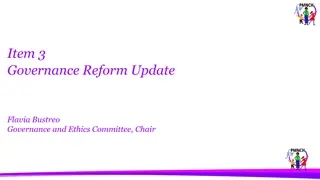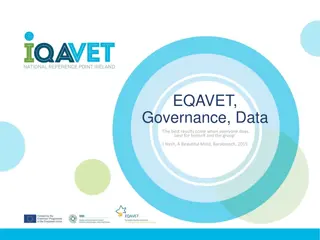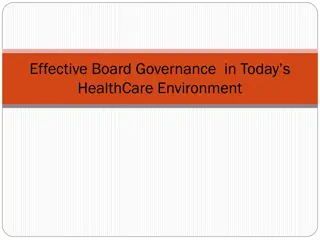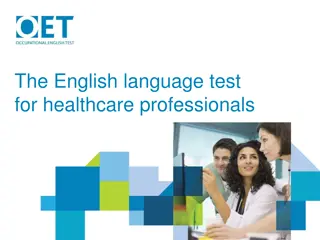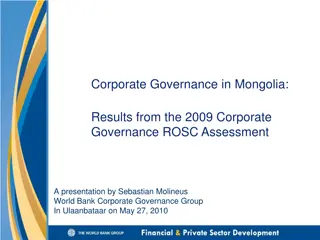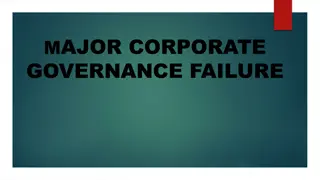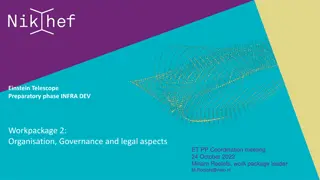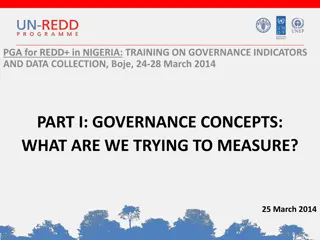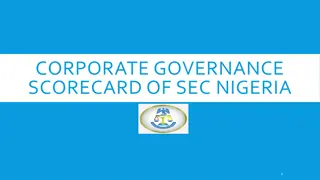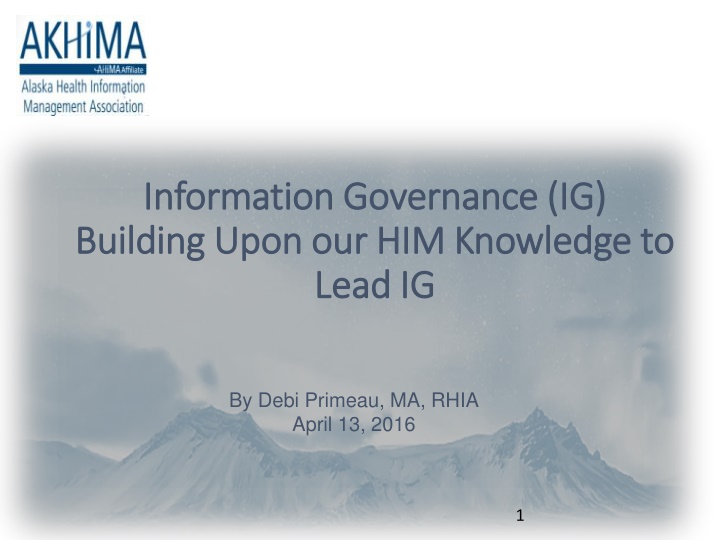
Building Information Governance in Healthcare
Enterprise Information Management (EIM), IT Governance, and Information Governance (IG) are crucial for maintaining information integrity, security, and quality in healthcare organizations. This article explores the role of Health Information Professionals in IG and outlines the importance of understanding data governance distinctions.
Download Presentation

Please find below an Image/Link to download the presentation.
The content on the website is provided AS IS for your information and personal use only. It may not be sold, licensed, or shared on other websites without obtaining consent from the author. If you encounter any issues during the download, it is possible that the publisher has removed the file from their server.
You are allowed to download the files provided on this website for personal or commercial use, subject to the condition that they are used lawfully. All files are the property of their respective owners.
The content on the website is provided AS IS for your information and personal use only. It may not be sold, licensed, or shared on other websites without obtaining consent from the author.
E N D
Presentation Transcript
Information Governance (IG) Information Governance (IG) Building Upon our HIM Knowledge to Building Upon our HIM Knowledge to Lead IG Lead IG By Debi Primeau, MA, RHIA April 13, 2016 1
Objectives Objectives Define enterprise information management and information governance for healthcare Review trends driving the need for information governance Distinguish between information governance (IG), data governance, and information technology (IT) governance Assess your organization s IG maturity Explore the role of HI Professionals in Information Governance 2
Basic Definitions Basic Definitions Enterprise Information Management (EIM) involves the infrastructure, policies, and procedures to ensure information is trustworthy across the organization 3
Types of Governance Types of Governance IT Governance Information Governance Data Governance 4
Information Governance Information Governance Information Integrity and Quality Information Analysis, Use and Exchange Information Design and Capture Information Governance Access, Security, and Confidentiality Content and Records Management 5
Information Governance Information Governance Information Integrity and Quality Information Analysis, Use and Exchange Information Design and Capture Information Governance Access, Security, and Confidentiality Content and Records Management 6
Information Governance Information Governance Information Integrity and Quality Information Analysis, Use and Exchange Information Design and Capture Information Governance Access, Security, and Confidentiality Content and Records Management 7
Information Governance Information Governance Information Integrity and Quality Information Analysis, Use and Exchange Information Design and Capture Information Governance Access, Security, and Confidentiality Content and Records Management 8
Information Governance Information Governance Information Integrity and Quality Information Analysis, Use and Exchange Information Design and Capture Information Governance Access, Security, and Confidentiality Content and Records Management 9
Information Governance Information Governance Information Integrity and Quality Information Analysis, Use and Exchange Information Design and Capture Information Governance Access, Security, and Confidentiality Content and Records Management 10
Information Governance Information Governance Information Integrity and Quality Information Analysis, Use and Exchange Information Design and Capture Information Governance Access, Security, and Confidentiality Content and Records Management 11
What Is Governance? What Is Governance? In the case of a business or organization, governance relates to consistent management, cohesive policies, guidance, processes, and decision-rights for a given area of responsibility. 12
TRENDS DRIVING INFORMATION TRENDS DRIVING INFORMATION GOVERNANCE GOVERNANCE 13
Why Now? Why Now? Increasing focus on healthcare data and HIT to drive improved care Rapid adoption of technology; shift from paper- based processes is needed Mergers and acquisitions; new organizational care models 14
Specific Drivers of Specific Drivers of Information Governance Information Governance Technology Cost Innovation Safety Healthcare consumers Legal and compliance pressures MU, MACRA, MIPS Population Health 15
Population Health Management Population Health Management Population Health Management is the: Aggregation of patient data across multiple health information technology resources The analysis of that data into a single, actionable patient record, and The actions through which care providers can improve both clinical and financial outcomes. 16
17 SOURCE: CTG Health Solutions and Clinovations. Population Health Management: Leveraging Data and Analytics to Achieve Value. 2012. http://www.clinovations.com/upload/Press%20Releases/Clinovations_PopulationHealthManagement_BriefingPaper.pdf
Population Health Population Health Information Information Management Management Population data that will need to be available for analysis includes those patients who are: WELL (need health wellness and prevention) AT RISK for health problems (need screening and lifestyle changes) Have CHRONIC conditions (need to prevent further complications) 18
What Are the Potential Benefits? What Are the Potential Benefits? More accurate data and information; Data-driven decision-making, at increased speed Better security of data and information Organization is prepared to advance interoperability and HI exchange Potential of achieving lower costs related to data and information management 19
Information Governance Benefits Information Governance Benefits Improved decision-making Reduced operational friction Protection of the needs of data and information stakeholders Standard, repeatable processes for data and information management Ultimately: Lower costs and increased efficiency of information management processes 20
Justification Justification ...the business costs of non-quality data, including irrecoverable costs, rework of products and services, workarounds, and lost and missed revenue may be as high as 10 to 25 percent of revenue or total budget of an organization. Father of Data Quality Larry English 21
What Does IG Look Like? What Does IG Look Like? Three Layers of Governance: Executive Leadership drives strategic direction for information management Multidisciplinary Steering Groups address specific priorities Working groups address operations 22
IG Model IG Model 23
Creating the Vision Creating the Vision Raise awareness of the value of the organization s information assets Do you/can you measure the actual and potential value generated from your organization s information assets? Consider positive and negative values 24
IG Implementation IG Implementation In a study conducted by AHIMA in 2014, most healthcare organizations are still in the beginning phase of adopting Information Governance programs. Another poll by AHIMA indicates that nearly one-third of healthcare organizations about 35 percent only have plans for Information Governance. Major setback in the healthcare industry s Information Governance practices. Healthcare organizations have an obligation to define the uses of information as well as policies and practices used for governing the information. What is the current status of Information Governance in your organization? 25
IG Implementation IG Implementation No one size fits all approach to Information Governance Minimum of 12-18 months for developing the program Start with an assessment of current state Continuous review and refining Recognition of the impact of the Information Governance program on the organizational goals is the key for acceptance Stakeholders must be educated Benefits must be realized 26
IG Implementation IG Implementation Develop a compelling business case Conduct a current state assessment Understand the organization s strategy and long term goals Develop strategy, identify goals and define purpose of program Build leadership support for the vision of managing information as an asset. Establish an authority to develop policies, processes, standards, definitions and metrics Create a high level work plan and define measures of success 27
Lead from Any Seat Lead from Any Seat Data Administrator Data Mining Clinical Terminologies ICD-10-CM/PCS Classification codes Governmental Audits Privacy and Security related to Access Quality/Compliance Chief Knowledge Officer EMPI Manager Others? 28
Assessing Your Information Assets Assessing Your Information Assets What are the main repositories of information in your organization? Classification Visibility How are they used to drive business value? Clinical or business decision-making Reimbursement or financial Measurements of quality or other performance goals External reputation 29
Assessing Your Organizations Assessing Your Organization s IG State IG State For each repository: Policies and procedures addressing EIM components? Are they followed manually or through technology? Is there an organizational leader with responsibility for the domain? Is this repository covered by an overarching governing body? 30
Assessing the Health of Your Clinical Assessing the Health of Your Clinical Information Assets Information Assets Do you know where the data are? Who controls the data? Do you know who will use the data? Does your organization need to better safeguard Does your organization need to keep auditors and information? Does your organization need to improve data quality? Are you ready for Population Health Management? regulators satisfied? 31
Best Practice Best Practice Commit from the Top Down Commit from the Top Down Executive Leadership (CEO, CIO, CFO) are critical stakeholders, and must take responsibility for the information management. Steering Committee should include individuals from many areas: Revenue cycle Patient registration Health information Clinical Data quality/compliance Information technology 32
Best Practice Best Practice Work from the Bottom Up Work from the Bottom Up Data Dictionary: A tool for supporting documentation that provides a descriptive list of names, definitions, and attributes of data elements to be captured in an information system or database Supports data sharing, exchange, and integration 33
Best Practice Best Practice Keep Training Keep Training Share the results of your efforts with operational teams: Registration/access staff can use data dictionary as a training resource Reporting staff can use the data dictionary to better understand data meaning 34
Best Practice Best Practice Communicate Communicate Communication may include questions such as: Are we making progress? Are we improving our data integrity? Are we reducing our error data-related tasks? 35
IG Maturity Assessment Sample IG Maturity Assessment Sample No recognized need;Have not started a formal program or initiative Recognized need;Have not started a formal program or initiative Program initiated Program initiated and benefits have been realized Don't know What is the status of the Information Governance in the organization? One year or less More than one year How long its been since the Information Governance has been implemented? Yes No Somewhat Don't know Is the IG program effective in the organization? Yes No Don't know Can the IG program be improved? Yes No Not yet; Working on the strategy Don't know Does the organization have a strategy to guide the Information Governance program in the future? ACCOUNTABILITY Who oversees the Information Governance program? Is there a formal Information Governance committee? Who all are included in the IG committee? Is the roles of the Information Governance committee members defined? Is the organization having a collaborative approach in establishing information governance? Is there adequate policies and procedures to guide the IG program? Are the policies and procedures documented, approved and communicated? Is the governing body regularly reported about the processes and improvements? Who documents the policies and procedures? Is the workforce continously being trained and updated about policies and practices? Is there a meeting schedule and how often is the meeting held? Are there audit trails to measure the performance and compliance of the IG program? Are the audit results reviewed and reported to the authority? What are the challenges faced? 36
Benefits of a Mature IG Program Benefits of a Mature IG Program Optimized access to information through processes and technology that maintain confidentiality and security Decreased liability through maintenance of an accurate and complete clinical record Better and faster data-driven decision-making Decreased risk of litigation based on appropriate retention of data Decreased liability and enhanced reputation through reduction of breaches 37
IG Maturity IG Maturity Business-Led and Business-Driven Measurable Differentiated Achievable Avoids complexity Communicable Copes with uncertainty Flexible Not prescriptive 38
Professional Development for HIM Professional Development for HIM 39
Impact of Affordable Care Act Impact of Affordable Care Act Careers in health information are increasing due to ACA and HIE EHR Implementations are driving increased need for leaders in IG Focus on Health Informatics Increasing demand for HIM Professionals who understand data and data flow 40
HIM Opportunities HIM Opportunities HIM professionals play critical roles in maintaining, collecting and analyzing the data that doctors, nurses, and other healthcare providers rely on in the delivery of quality healthcare. Patient Health Information Management Medical Records Administration Computer Information Systems Management Diagnosis and Procedure Coding Personnel and Budget Administration Quality Improvement Research
HIM: Employers HIM: Employers Physician offices and clinics Long-term care facilities Insurance companies Government agencies Home care providers Behavioral health facilities Information systems vendors Rehabilitation centers Pharmaceutical companies Hospitals
Professional Development for HIM Professional Development for HIM Population Health as a Strategic Initiative Decreased healthcare costs Increased access Decreased disparities in care Leaders Needed to: Understand governance of data sources Understand how to use data to tell the story 43
Governing the Clinical Documentation Governing the Clinical Documentation Integrity Chain Integrity Chain E EH HR R C CO OD DI IN NG G D DO OC CU UM ME EN NT TA AT TI IO ON N A AN NA AL LY YT TI IC CS S C CO OM MP PL LI IA AN NC CE E C CD DI I P PA AT TI IE EN NT T E EN NC CO OU UN NT TE ER R Q QU UA AL LI IT TY Y R RE EP PO OR RT TI IN NG G
Professional Development for HIM Professional Development for HIM Building Your Skills Interoperable EHRs Design and Operations Know your data Become a Leader EHRs, IG, HIE, Documentation Integrity, Data Analytics, IT, Informatics, Project Management Treat coded data as a Strategic Asset 45
Professional Development for HIM Professional Development for HIM KEY: identifying and capturing the data on chronic care patients that are not in the hospital. Proactive identification of a patient population requires a new approach to information systems that can capture and collect data from EHRs and physician practice management. 46
Certification Opportunities Certification Opportunities Be a leader Make a statement AHIMA Certified Health Data Analyst (CHDA) AHIMA Certified Documentation Improvement Professional (CDIP) 47
Key Takeaways for HIM Professionals Key Takeaways for HIM Professionals 48
Benefits of an Information Governance Benefits of an Information Governance Program Program Governing clinical and operational information: Improves quality of care and patient safety Improves population health Increases operational efficiency and effectiveness Reduces costs Reduces risk Information Governance Principles for Healthcare (IGPHC). 49
What you can do to further Information What you can do to further Information Governance Governance Seek opportunities to identify areas within your department where IG can benefit your organization Develop policies and procedures with the entire enterprise in mind Expand skill sets in documentation, coding, regulatory compliance, EHRs Define your Core Clinical Documentation Record Set Policies must ID record documents and documentation Consider additional certifications Market your skills Advocate for Data Quality Educate your organization Embrace Change 50

